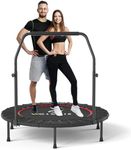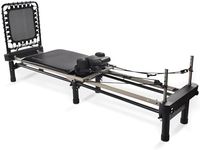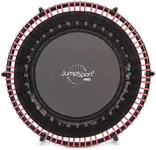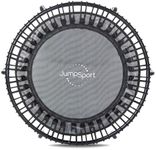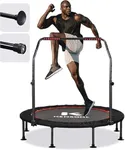Buying Guide for the Best Rebounders
Choosing the right rebounder, also known as a mini trampoline, can make a big difference in your fitness routine. Rebounders are popular for low-impact cardio, lymphatic health, and fun home workouts. When shopping for a rebounder, it's important to consider how you'll use it—whether for gentle bouncing, intense workouts, or rehabilitation. Understanding the key features will help you find a model that matches your needs, supports your body, and lasts for years.Mat SizeMat size refers to the diameter of the jumping surface. This is important because it affects how much space you have to move and how comfortable your workouts will be. Smaller mats (around 32-36 inches) are more compact and easier to store, making them good for tight spaces or light bouncing. Medium mats (36-40 inches) offer a balance between space and portability, suitable for most users and a variety of exercises. Larger mats (40 inches and above) provide more room for movement and are ideal if you want to do more dynamic routines or need extra stability. Think about your available space and the types of exercises you plan to do when choosing the right mat size.
Weight CapacityWeight capacity tells you the maximum user weight the rebounder can safely support. This is crucial for safety and durability. Lower weight capacities (up to 200 lbs) are suitable for lighter users and occasional use. Mid-range capacities (200-300 lbs) fit most adults and regular workouts. Higher capacities (over 300 lbs) are best for heavier users or those who want extra reassurance about the frame's strength. Always choose a rebounder with a weight limit above your own weight to ensure safe and long-lasting use.
Spring or Bungee SystemThe bounce mechanism can be either metal springs or elastic bungee cords. This affects the feel and impact of your workout. Spring systems tend to give a firmer, higher bounce and are often more affordable, but they can be noisier and harder on the joints. Bungee systems offer a softer, quieter, and lower-impact bounce, which is gentler on the body and preferred for longer sessions or rehabilitation. If you want a quiet, joint-friendly experience, look for bungee rebounders. If you prefer a firmer bounce and don't mind some noise, springs may be suitable.
Stability and Frame ConstructionThe frame's material and design determine how stable and durable the rebounder is. Steel frames are common and provide good strength, while reinforced or heavy-duty frames offer extra stability for vigorous workouts. Some rebounders have additional stabilizing features like non-slip feet or support bars. If you plan to do high-intensity routines or need extra support, look for a sturdy frame and consider models with stability bars. For light bouncing or portability, a basic frame may be enough.
Portability and StoragePortability refers to how easy it is to move or store the rebounder. Some models fold in half or have removable legs, making them easier to tuck away when not in use. If you have limited space or want to travel with your rebounder, look for folding designs or lightweight models. If you have a dedicated workout area, portability may be less important, and you can focus on other features.
Noise LevelNoise level is how much sound the rebounder makes during use. This matters if you live in an apartment, have housemates, or want to exercise quietly. Bungee rebounders are generally quieter than spring models. If noise is a concern, pay attention to user reviews or product descriptions that mention quiet operation, and consider bungee systems for the softest, least disruptive bounce.

